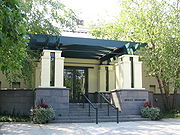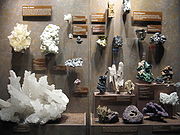
Bruce Museum of Arts and Science
Encyclopedia

Greenwich, Connecticut
Greenwich is a town in Fairfield County, Connecticut, United States. As of the 2010 census, the town had a total population of 61,171. It is home to many hedge funds and other financial service companies. Greenwich is the southernmost and westernmost municipality in Connecticut and is 38+ minutes ...
, Connecticut
Connecticut
Connecticut is a state in the New England region of the northeastern United States. It is bordered by Rhode Island to the east, Massachusetts to the north, and the state of New York to the west and the south .Connecticut is named for the Connecticut River, the major U.S. river that approximately...
with both art and science exhibition space. "The Bruce," as it's more familiarly known, has holdings of about 15,000 objects, including fine art, decorative art, natural history and anthropology.
A second location is maintained at Greenwich Point Park, focusing on beach-related exhibits, including a touch-tank. The museum also has a "Brucemobile" with exhibits in a traveling van. The museum hosts frequent lectures and social events.
Members total about 2,500, and over 400 volunteers contribute a total of more than 14,000 hours of their time each year. It has 32 full-time employees and nine more part-timers.
The Bruce's main building at 1 Museum Drive, sits on a hill in a downtown park, and its tower (not open to the public) can be easily seen by drivers passing by on Interstate 95
Interstate 95 in Connecticut
Interstate 95, the main north–south Interstate Highway on the East Coast of the United States, runs in a general east–west compass direction for 111.57 miles in Connecticut from the Rhode Island state line to the New York State line. I-95 Southbound from East Lyme to the New York State...
.
Exhibits at the museum change sixteen times a year, according to the museum, or fourteen times a year according to the town's Web page on the Bruce.
Art holdings
The art collection has a strong emphasis on the Cos Cob SchoolCos Cob Art Colony
The Cos Cob Art Colony was a group of artists, many of them American Impressionists, who gathered in and around Cos Cob, a section of Greenwich, Connecticut, from about 1890 to about 1920....
, an Impressionist school
Impressionism
Impressionism was a 19th-century art movement that originated with a group of Paris-based artists whose independent exhibitions brought them to prominence during the 1870s and 1880s...
, including paintings by Childe Hassam
Childe Hassam
Frederick Childe Hassam was a prolific American Impressionist painter, noted for his urban and coastal scenes. Along with Mary Cassatt and John Henry Twachtman, Hassam was instrumental in promulgating Impressionism to American collectors, dealers, and museums...
, Emil Carlsen
Emil Carlsen
Soren Emil Carlsen was an American Impressionist painter who emigrated to the United States from Denmark...
and Leonard
Leonard Ochtman
Leonard Ochtman was an American Impressionist painter who specialized in landscapes. He was born in Zonnemaire, Netherlands as the son of a decorative painter. His family moved to Albany, New York in 1866. Starting at a young age, Ochtman worked as a draftsman at a wood-working firm in Albany...
and Mina Fonda Ochtman. Sculpture includes nineteenth and twentieth century work by Auguste Rodin
Auguste Rodin
François-Auguste-René Rodin , known as Auguste Rodin , was a French sculptor. Although Rodin is generally considered the progenitor of modern sculpture, he did not set out to rebel against the past...
, Hiram Powers
Hiram Powers
Hiram Powers was an American neoclassical sculptor.-Biography:The son of a farmer, Powers was born in Woodstock, Vermont, on the July 29, 1805. In 1818 his father moved to Ohio, about six miles from Cincinnati, where the son attended school for about a year, staying meanwhile with his brother, a...
, Frederick MacMonnies and George Segal
George Segal (artist)
George Segal was an American painter and sculptor associated with the Pop Art movement. He was presented with a National Medal of Arts in 1999.-Works:...
.

Permanent Exhibits
The museum has permanent exhibits focusing on geologyGeology
Geology is the science comprising the study of solid Earth, the rocks of which it is composed, and the processes by which it evolves. Geology gives insight into the history of the Earth, as it provides the primary evidence for plate tectonics, the evolutionary history of life, and past climates...
, paleontology
Paleontology
Paleontology "old, ancient", ὄν, ὀντ- "being, creature", and λόγος "speech, thought") is the study of prehistoric life. It includes the study of fossils to determine organisms' evolution and interactions with each other and their environments...
, archeology, local Native Americans
Native Americans in the United States
Native Americans in the United States are the indigenous peoples in North America within the boundaries of the present-day continental United States, parts of Alaska, and the island state of Hawaii. They are composed of numerous, distinct tribes, states, and ethnic groups, many of which survive as...
, natural history
Natural history
Natural history is the scientific research of plants or animals, leaning more towards observational rather than experimental methods of study, and encompasses more research published in magazines than in academic journals. Grouped among the natural sciences, natural history is the systematic study...
, and the effects of man on the areas around Greenwich. There are several display cases with mineral
Mineral
A mineral is a naturally occurring solid chemical substance formed through biogeochemical processes, having characteristic chemical composition, highly ordered atomic structure, and specific physical properties. By comparison, a rock is an aggregate of minerals and/or mineraloids and does not...
specimens, including a touchable meteorite
Meteorite
A meteorite is a natural object originating in outer space that survives impact with the Earth's surface. Meteorites can be big or small. Most meteorites derive from small astronomical objects called meteoroids, but they are also sometimes produced by impacts of asteroids...
, large mineral crystals from around the world and minerals that glow in black light
Black light
A black light, also referred to as a UV light, ultraviolet light, or Wood's lamp, is a lamp that emits ultraviolet radiation in the long-wave range, and little visible light...
. Part of a Northeast woodland wigwam
Wigwam
A wigwam or wickiup is a domed room dwelling used by certain Native American tribes. The term wickiup is generally used to label these kinds of dwellings in American Southwest and West. Wigwam is usually applied to these structures in the American Northeast...
has been created as a seating area to learn about Native Americans, and there is a model of an archaeological dig. There are several cases focusing on the changes in the land and environment of Greenwich from pre-settler days up until the early 1900s. A large exhibit focuses on different prehistoric eras and fossils associated with those times. A fifteen foot diorama
Diorama
The word diorama can either refer to a nineteenth century mobile theatre device, or, in modern usage, a three-dimensional full-size or miniature model, sometimes enclosed in a glass showcase for a museum...
displays local woodland wildlife. Other display cases show more birds and animals found in the area. A marine tank holds live small fish
Fish
Fish are a paraphyletic group of organisms that consist of all gill-bearing aquatic vertebrate animals that lack limbs with digits. Included in this definition are the living hagfish, lampreys, and cartilaginous and bony fish, as well as various extinct related groups...
, crabs and sea stars for close examination.
Comments on the museum
A reviewer for the Wall Street Journal praised the "urbane Peter C. Sutton [director of the museum], a splendidly connected director of impeccable academic credentials, the Bruce -- with nothing to loan -- has been scoring quite a few coups of late. (A fall show of the 17th-century master Jan van der Heyden, inventor of the cityscape, is a joint project with the RijksmuseumRijksmuseum
The Rijksmuseum Amsterdam or simply Rijksmuseum is a Dutch national museum in Amsterdam, located on the Museumplein. The museum is dedicated to arts, crafts, and history. It has a large collection of paintings from the Dutch Golden Age and a substantial collection of Asian art...
, Amsterdam.)" The reviewer also mentioned Sutton's partnership with Edgar Peters Bowron, a curator of European art at the Museum of Fine Arts, Houston, and the art historian Robert Rosenblum for the museum's exhibition on the dog in art, which garnered loans from The Louvre, the Prado and other major museums.
History
In 1908, Robert Moffat Bruce (1822-1908), a wealthy textile merchant, deeded the home he had originally bought in 1858 to the town of Greenwich with the stipulation that it be used "as a Natural History, Historical and Art Museum, for the use and benefit of the public."The first exhibition featured works by the Greenwich Society of Artists, several of whom were members of the Cos Cob Art Colony
Cos Cob Art Colony
The Cos Cob Art Colony was a group of artists, many of them American Impressionists, who gathered in and around Cos Cob, a section of Greenwich, Connecticut, from about 1890 to about 1920....
. The museum hosted the society's annual exhibition from 1912 to 1926. Artwork from the Cos Cob School forms the nucleus of the Museum's holdings.
In 1992 governance of the museum was restructured, with the Bruce Museum, Inc. established as a non-profit organization. That same year the museum started a project to completely renovate its building.
When it reopened in September 1993, museum featured an architectural structure wrapped around the original building, housing galleries for art on one side of the main pavilion with galleries of environmental history on the other.
"Continued growth over the years in attendance, exhibitions, public programs, and collections is leading the Bruce to undertake an architectural study of its future space and facilities needs," according to the Town of Greenwich Web page on the Bruce.
Events
Lectures, etc.The Bruce's Bantle Lecture Gallery has more than 100 events each year related to exhibitions and collections. Regular events include the "Hascoe Art Lecture Series," "Science Lecture Series," "Dinner-Lecture Series," "Trips and Tours, and " the "Robert Bruce Circle."
Family Days, Music and Workshops
The Bruce hosts "Family Days," "Music at the Bruce" concerts for children and adults, and special teachers' workshops.
Arts and Crafts Festivals
Each October the museum presents the Outdoor Arts Festival and each May its Outdoor Crafts Festival. Both are juried events featuring artisans from across the country.
Renaissance Ball
The Bruce Museum’s Renaissance Ball has been the highlight of Greenwich’s social season for the past 23 years. Always held the first Saturday in June, the annual black-tie event is the Museum's major fundraiser, with net proceeds accounting for nearly 20% of the Museum's annual budget and earmarked for education programs and exhibitions.
Icon Awards in the Arts
Bruce Museum Icon Awards in the Arts will honor those who have demonstrated commitment to the arts. Artists, collectors, art business leaders, art critics, patrons of the arts, and art historians will be honored in an evening ceremony and cocktail event taking place at a private residence in Greenwich.

